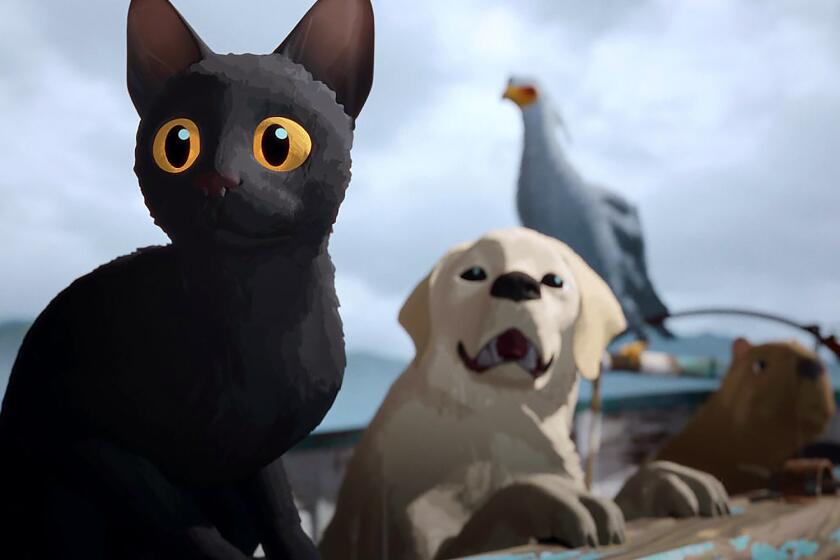‘Blackfish,’ other animal documentaries move far beyond the cuddly
The new documentary “Blackfish” opens with footage of a killer whale and a human being beneath the water’s surface. As their forms become entangled, it looks as if they are involved in some kind of struggle, and the moment grows increasingly ominous. Suddenly the animal charges at the human.
As the image cuts to above the water, the human is spectacularly launched into the air — in what turns out to be a dynamic move in a marine park show. Things are not as they first seemed.
The riveting film examines the treatment of killer whales at SeaWorld parks by focusing on Tilikum, a 6-ton, 22-foot animal that has been involved in three deaths, including the February 2010 incident in which he killed trainer Dawn Brancheau. “Blackfish” goes back through Tilikum’s life with the structure of a police procedural, transforming the animal into an enigmatic character who remains teasingly beyond our understanding.
PHOTOS: Hollywood backlot moments
“Blackfish” joins a recent series of artful animal films, carefully constructed to move beyond cuddly creatures and pictorial beauty to investigate the sometimes-brutal, often-awkward collision of modern humans with the natural, untamed world. Even with the wide array of nature/travelogue imagery available on television, some of it breathtaking, these films stand apart for their sharply focused examinations of our relationship to the world around us.
Director Gabriela Cowperthwaite gained access to some of the footage in “Blackfish” through public records requests after it was entered as evidence in a case brought by the Occupational Safety and Health Administration against SeaWorld following Brancheau’s death. (As a result of that ruling, trainers are currently not allowed in the water with killer whales during shows without a physical barrier.) The footage that opens the film was taken earlier by one of the trainers to examine their performance.
“It’s the tension between what’s going on underneath the surface, metaphorically, and what’s going on above the surface where it’s all cheerful and sunny,” explained Cowperthwaite of how the ambiguity of that footage jumped out at her when she first saw it. “There is a fine line between the two.”
This year has already seen the release in Los Angeles of films such as Denis Côté’s “Bestiaire,” set amid an animal park in Quebec, Canada, and Lucien Castaing-Taylor and Verena Paravel’s immersive “Leviathan,” set on board a North Atlantic fishing ship. Castaing-Taylor had previously collaborated on the acclaimed, atmospheric sheep-herding documentary called “Sweetgrass,” which emphasized the rigor and hard work of long companionship with the noisy, four-legged creatures.
James Marsh followed up his Oscar-winning “Man on Wire” with “Project Nim,” about a chimpanzee raised as a human. Werner Herzog’s 2005 film “Grizzly Man,” about a man who lived and died among bears in Alaska, may be the spiritual and stylistic forerunner of this current wave of documentaries.
“These animal films are so fascinating in terms of the moving target of the boundary between ourselves and the animal, and the extent to which we resist and indulge in anthropomorphizing them,” said Caroline Libresco, senior programmer at the Sundance Film Festival, where “Blackfish” premiered earlier this year and many other recent animal documentaries have played.
In the 2012 fiction film “Rust and Bone,” Marion Cotillard played a trainer at an aquatic park in France who loses her legs in a killer whale attack. Later in the film she returns to the park and through the side of a tank interacts with the animal, who mimics her gestures. Similar moments where humans are seemingly in tune with killer whales haunt “Blackfish.”
“It’s one of the hardest things for really anyone to come to terms with, that all you can know is how you feel about the animal. To represent their side of the equation, you have to make up a story,” said Cowperthwaite, a longtime documentarian whose previous work includes a look at an inner-city lacrosse team.
“You get a sense that you’re looking and something is meeting you,” said Samantha Berg, one of the former SeaWorld trainers featured in “Blackfish.” “I think people then make up a lot of stories, people who think they are having a relationship with the animal and connecting with them. But there’s a feeling like there’s a two-way connection even if there isn’t.”
PHOTOS: Billion dollar box office club
SeaWorld declined to be interviewed for “Blackfish” and has challenged its credibility, declaring in a message sent to movie critics that the film is “deliberately misleading and scientifically inaccurate.”
For Côté, part of the inspiration for his stately and mysterious “Bestiaire” came from asking himself whether it was possible to film an animal in an original way, to show it in a way audiences hadn’t seen before. His conclusion was to place the camera in front of the animals and allow them to look back.
“You’re trying to find a connection between you and another living being and there is something abstract and also physical about it and hopefully that’s what’s working in the film,” said Côté in a recent call from Montreal.
“I didn’t want to do any sort of anthropomorphism,” Côté added. “Can we film an animal for what it is, an animal? I was looking for pure animality. I wasn’t trying to connect myself as a human with the animals.”
The very unknowability of animals, the temptation for filmmakers to try to understand them, or at the very least to understand those humans who seem most intimately connected to them, might be a driving force behind these recent films. Cowperthwaite recalled the first time she saw Tilikum with her own eyes at SeaWorld Orlando, after the whale had returned to performing following Brancheau’s death.
“To be perfectly honest, I was terrified of Tilikum. When I read that autopsy report and read how deliberate and tragic that killing was, I didn’t have a natural empathy for Tilikum,” she said. “It was almost like I had to reconcile those feelings with myself and realize that in order for me to come to understand this protagonist/antagonist, I would have to go back and give him a psychological profile to try to figure out how an animal we think of as so intelligent could have made that decision.”
As Libresco noted, “It’s almost like, how did Hannibal Lecter get this way?”
Tellingly, “Leviathan’s” daring cinematography at times is oriented from the point-of-view of the fish and birds that encounter a North Atlantic fishing boat. “Humanity, we hope, ends up being cast in a more humble light,” said filmmakers Castaing-Taylor and Paravel in a joint email while preparing to shoot their next project in Japan.
“Blackfish” blurs the distinction between procedural thriller, empathetic psychological portrait and call-to-action. Even with the growing storm the film has touched off, Cowperthwaite expressed concern the film not be seen only as advocacy-oriented rabble-rousing.
“I didn’t want it to be an issue documentary where I’m shoehorning in all these incendiary facts designed to make an audience feel hysterical. I wanted to tell a fact-based story from beginning to end,” she said. “Having a strict narrative and adhering to the fact this was Tilikum’s story allowed me to stay disciplined. I came to the conclusion, maybe it really is just that shocking.”
Follow Mark Olsen on Twitter: @IndieFocus | Google+
More to Read
Only good movies
Get the Indie Focus newsletter, Mark Olsen's weekly guide to the world of cinema.
You may occasionally receive promotional content from the Los Angeles Times.











